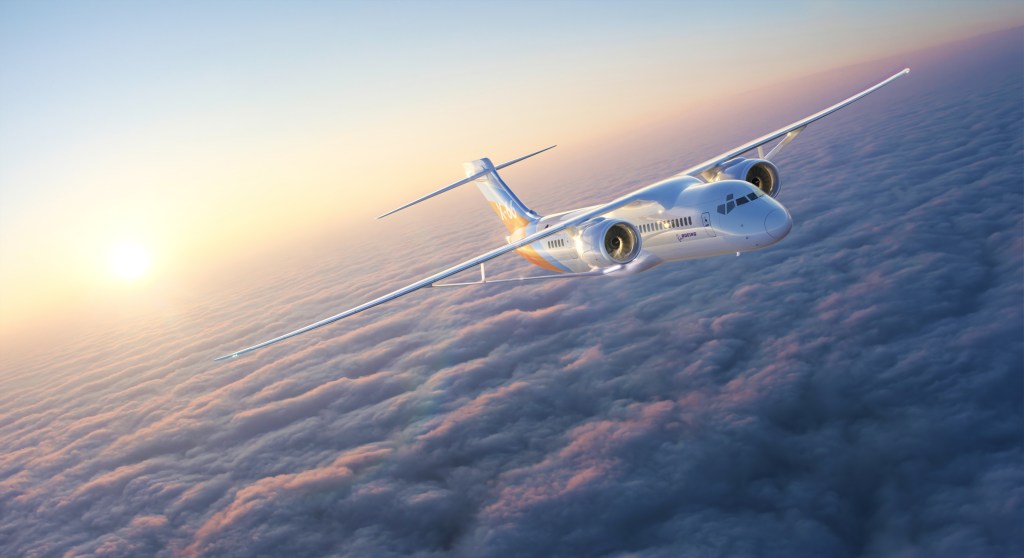
By Bjorn Fehrm
March 15, 2024, ©. Leeham News: We started the series a year ago about the New Aircraft Technologies that can be used when replacing our present single-aisle airliners.
We have covered a lot, including the typical development phases, from initial studies to preparing for the aircraft’s in-service phase.
Let’s make a resume of what we have discussed.

Figure 1. Boeing’s Truss Braced Wing X-66A demonstrator based on the MD-90. Source: Boeing.
New Aircraft Technologies
Over the 49 articles, we have covered a lot. Let’s run through what we looked at and learned about the ideas and technologies that can come to use for the replacement of the present single-aisle Airbus A320 and Boeing 737 MAX series:
- The first question is the airplane’s configuration. Are alternatives to the tube with wings mature enough to be considered? We must realize that the single-aisle is the backbone earner of both Airbus and Boeing. Companies will have a very low-risk appetite, as failure can risk them. In summary, we can assume that the next generation will keep the tube with wings.
- The next question is whether to keep the single-aisle configuration or if the yearly increase in passenger volumes and increasing slot constraints at key airports will favor a shorter and higher-capacity dual-aisle configuration. It all depends on the projected passenger growth. The problem is to project the movement of the heart of the market correctly over the new airliner’s 50-year lifetime.
- We then looked at the aerodynamic advancement that new aerodynamic tools, structural materials, and control techniques enable. Boeing put the folding wingtip onto airliners with the 777X. We can assume that the folding wingtip will appear on the new generation aircraft. Boeing is also exploring the next step in wider wings (to reduce the induced drag), which is the Truss-Braced Wing (TBW). The question is, will the test with a truss-braced wing on an MD-90 (Figure 1) give Boeing the confidence to dare it for the next generation? We will know by the end of the decade.
- To enable a more advanced aerodynamic shape at the lowest aircraft mass, we need materials that allow wings with advanced shapes and curvatures and strong and durable fuselages. The wing material will most likely be the classical thermoset composite, which cures chemically and is then joined with bolts (called fastened in aero-speak) into larger assemblies. The more complicated fuselage would benefit from a less workhour intensive assembly method than the bolting’s “drill and fill’. It’s where the heat-matured thermoplastic composite would allow the welding of parts into assemblies, much like car chassis parts are spot-welded into the final chassis.
- The airframe classically represents about one-third of the gain in efficiency and new engine technology two-thirds. The problem with the classical turbofan engine is the easiest efficiency improvement is to decrease the average exhaust speed of the hot gases leaving the engine (the gas overspeed versus the surrounding air), which increases the propulsive efficiency. The problem is that the method to get there, to increase the ByPass Ratio (BPR), was used heavily for the last generations, from BPR around 4 for the CFM56 generation to BPR 12 for the Pratt & Whitney GTF, an increase of three times. It will not be possible to increase the classical turbofan BPR another three times, which would be a BPR of 30+. The engine and its nacelle would be too large.
- The technology that can achieve a BPR of 30+ is the Open Rotor technology, which can achieve BPRs of double that. GE and SAFRAN propose a simplified Open Rotor for the next-generation aircraft called RISE (Revolutionary Innovation for Sustainable Engines). It puts the rotor at the front, with a non-rotating vane stage working as the de-swirler behind the single rotor. It simplifies the Open Rotor configuration without sacrificing efficiency.
- The other major efficiency improvement is found in the engine core, where new design principles and materials enable more efficient air compression, combustion, and power extraction. However, this increases the mechanical and thermal loads. It has led to the present crisis in engine durability, where airlines suffer with aircraft grounded. We will do a follow-up series about what can be done to change this situation.
We continue to Wrap our series in the next Corner.
Related

